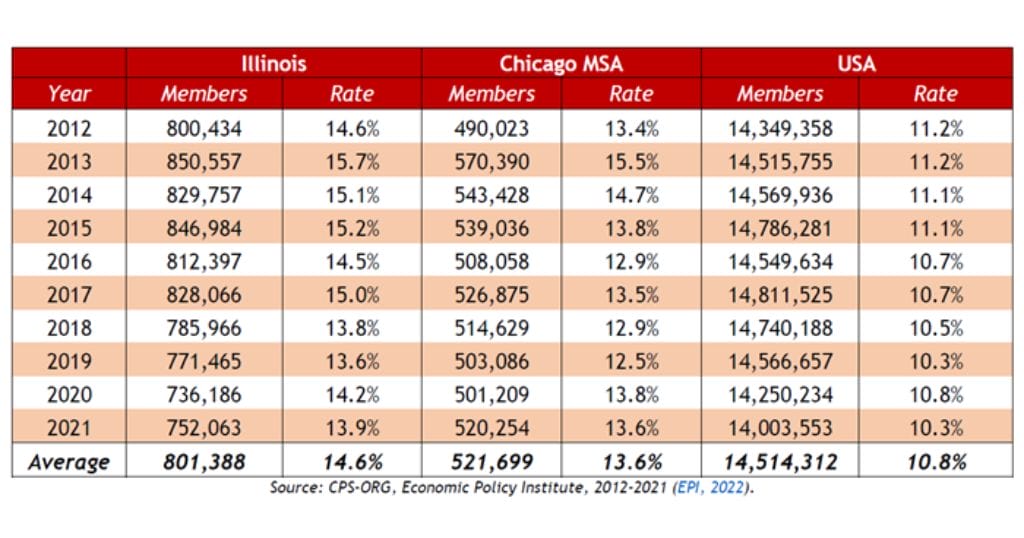Survey: Public support for unions hits 57-year high nationally
As voters in Illinois prepare to decide on a state constitutional amendment that would guarantee workers the right to organize, a new study shows union membership in the state grew last year for the first time in four years.
The study also showed, however, that the overall percentage of the state’s workforce that was in a union declined from one year ago.
The analysis by the pro-union Illinois Economic Policy Institute and the Project for Middle Class Renewal at the University of Illinois Urbana-Champaign showed that union membership statewide grew a little more than 2 percent, to 752,063, over the previous year. That was still below the 2017 level of 828,066.
And while it may be too early to tell whether that’s a temporary blip or the beginning of a longer-term trend, UIUC’s Robert Bruno, a coauthor of the report, said there are other signs of a rebound in the labor movement.
“There’s certainly strong indicators that some significant renewal is likely to happen, that this is more than just some sort of oddity in the labor markets,” he said.
In addition to their own findings, Bruno and IEPI’s Frank Manzo pointed to a Gallup survey released Aug. 30 that showed 71 percent of Americans approve of labor unions. That’s up from 64 percent before the pandemic and is the highest approval rate Gallup had recorded since 1965.
“And that is a 23-percentage point increase since 2009,” Manzo said. “I mean, the trend line is up, up, up since 2009.”
In addition, they pointed to a 60 percent success rate for union organizing petitions in Illinois last year, the highest in more than a decade, with workers under age 35 and female workers showing the largest growth in unionization rates.
Overall, 13.9 percent of Illinois workers were represented by a union, down from 14.2 percent the previous year and 15 percent in 2017. Nationally, however, only 10.3 percent of U.S. workers were union members in 2021, down from 10.7 percent in 2017.
State and local government workers still make up the overwhelming majority of union workers in Illinois, with 49.9 percent of those workers belonging to unions compared to 8.6 percent of private sector workers.
But the unionization rate among public sector workers in Illinois has been declining, due in large part to the U.S. Supreme Court’s 2018 decision in Janus v. AFSCME Council 31. In that Illinois case, the court said the state could not require public sector employees to pay what are known as “agency fees” to their unions – the part of a union’s membership dues that cover the cost of collective bargaining.
The 49.9 percent of public sector workers belonging to a union represented a 2.2-percentage point decrease from pre-Janus levels.
But unionization rates have been growing in the private sector, which was not affected by the Janus ruling, as more and more workers have begun to organize in the wake of the COVID-19 pandemic.
“There is a lot of grievance, a lot of angst, about what workers experienced in the last two-and-a-half years,” Bruno said. “Very difficult working conditions.”
Bruno said the COVID-19 pandemic led to “a raising of consciousness” for “millions of workers.”
“They are now so aggrieved by those conditions that they’ve come to understand that they need a collective response,” he said.
Previously in Illinois, former Republican Gov. Bruce Rauner sought to weaken labor unions by unsuccessfully working to ban some political contributions by public employee unions and allow local governments to establish “right-to-work zones.”
In 2019, Democratic Gov. JB Pritzker signed legislation specifically prohibiting local governments from enacting such laws. And last year, state lawmakers went even further by proposing a constitutional amendment to protect workers’ rights to organize.
The proposed amendment, which will be on ballots in the Nov. 8 general election, would add a new section to the state constitution’s bill of rights. The first sentence would establish a “fundamental right” of employees “to organize and bargain collectively through representatives of their own choosing for the purpose of negotiating wages, hours, and working conditions, and to protect their economic welfare and safety at work.”
The second sentence would prohibit the General Assembly or any local government from interfering with that right or from enacting right-to-work laws.
It would provide that, “No law shall be passed that interferes with, negates, or diminishes the right of employees to organize and bargain collectively over their wages, hours, and other terms and conditions of employment and work place safety, including any law or ordinance that prohibits the execution or application of agreements between employers and labor organizations that represent employees requiring membership in an organization as a condition of employment.”
The proposal has sparked opposition from the Liberty Justice Center and the conservative Illinois Policy Institute, which have tried – unsuccessfully, so far – to have it removed from the ballot. They argue in part that the amendment would be preempted by the National Labor Relations Act, at least regarding private-sector unions, and would therefore be unconstitutional under federal law.
In May, a Sangamon County judge rejected that argument, and in August the 4th District Court of Appeals upheld that decision. The plaintiffs are now trying to get their case before the Illinois Supreme Court.
Manzo, meanwhile, argued that even if federal law does preempt state action, a state constitutional amendment could still serve as a backstop in the event federal protections are ever taken away.
“Similar to recent decisions on reproductive rights at the Supreme Court level that have taken away rights that have long been held by a certain segment of the population and saying it’s kind of up to the states,” he said. “Should that happen for this segment of the population called workers, and rights are taken away at the federal level, or at least removed as being a federal right, or even if Congress were to just get rid of the National Labor Relations Act in a couple months, this would be an answer at the state level.”
Capitol News Illinois is a nonprofit, nonpartisan news service covering state government that is distributed to more than 400 newspapers statewide. It is funded primarily by the Illinois Press Foundation and the Robert R. McCormick Foundation.






